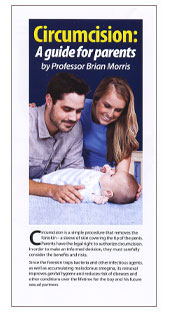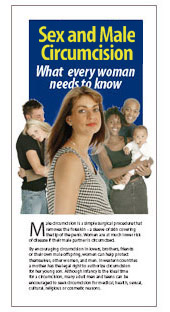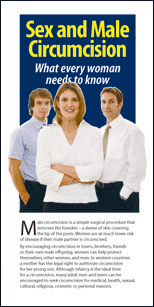Circumcision - Whose Responsibility? – Legal and Ethical Arguments
Parents or legal guardians have the legal right to authorize surgical procedures in the best interests of their children [American., 1995; Etchells et al., 1997; Viens, 2004; Gostin & Hankins, 2009]. As pointed out in a review by circumcision experts in a respected pediatrics journal in Jan 2010, parents make many medical decisions on behalf of their young children. For example, immunization entails risk, but confers long-term benefit. The American Academy of Pediatrics and other medical bodies around the world endorse vaccines for prevention of infections, so long as the parents are informed of the potential risks and benefits, and consent to the vaccination procedure [Tobian et al., 2010]. Either parent has the legal right to decide to circumcise their infant or child.
In a survey of African-American parents, 96% considered that circumcision was healthy, 87% believed it was safe, 72% thought it was necessary, 41% cited health reasons as the most important factor in their decision, and the mother was 12 times more likely than the father to make the final decision [Ahaghotu et al., 2009].
“National laws should allow mature minors the opportunity to make decisions about circumcision for themselves or at least empower boys to participate in the decision-making process in an age-appropriate manner” [Gostin & Hankins, 2009].
It is argued by opponents of circumcision that ONLY the male himself should be the one to make the decision about whether he does or does not want to be circumcised. That is, that only when he is grown up enough should he decide to be circumcised, rather than permit parents to make this decision on his behelf when he is a baby. This is the so-called “right to self-determination” argument.
There are, however, problems with this argument, not the least of which is the fact that the greatest benefits accrue the earlier in life the procedure is performed. If left till later ages the individual has already been exposed to the risk of urinary tract infections that often damage the vulnerable pediatric kidney and can lead to lifelong renal problems and cardiovascular disease, the physical problems such as phimosis and paraphimosis, the inflammatory skin conditions such as balanitis and balanoposthitis, and means he will carry a residual risk, albeit reduced compared with no circumcision, of penile cancer and possibly HIV infection.
Moreover, it would take a very “street-wise”, outgoing, adolescent male to make this decision and undertake the process of ensuring that it was done. Perception of risk among young men is highly distorted, many not being able to perceive themselves as being at risk of, say, HIV infection [Pettifor et al., 2005].
Awareness of the vagaries of adolescent decision-making would cause many parents to quite reasonably choose infancy for their son’s circumcision [Rennie et al., 2007]. Moreover, most males in their late teens and 20s, not to mention many men of any age, are reticent to confront such issues, even if they hold private convictions and preferences about wanting to be rid of the foreskin from their penis.
Furthermore, despite having problems with this part of their anatomy, many will suffer in silence rather than seek medical advice or treatment. Thus to argue that circumcision be delayed until the male can make his own decision is specious. By the teen or later years the procedure is no longer as fast, simple, cheap or as pain-free, and a general, as opposed to a local, anesthetic is more likely to be employed. A general anesthetic carries some, albeit low, risks, and is not absolutely necessary. It is, however, preferred by surgeons for longer procedures such as the most involved (sleeve-resection) technique. Later circumcision also means a more complex surgical procedure. Since the penis is larger, the surgery takes longer to do, and the healing process is longer, the entire undertaking by the male is in most instances inconvenient, requires abstinence from sex to avoid infections from STIs, including HIV, and the cosmetic result, although usually very good, will not be as good as most infant circumcisions are.
For a comprehensive overview of the issues one needs to be aware of the reader is referred to “A ‘snip’ in time: what is the best age to circumcise” published in BMC Pediatrics [Morris et al., 2012b].
Really though, parental responsibility must over-ride arguments based on “the rights of the child”. Think what would happen if we allowed children to reach the age of legal consent in relation to, for example, immunization, whether they should or should not be educated by going to school every day, or even whether they should or should not perform daily routines such as tooth-brushing, the type of food or beverages they consume in the interests of their health, whether they should exercise or not and how to do so safely, how much television they should watch and what programs are suitable for their age, whether they should decide what is responsible behavior, whether or not they should show respect for others, and know what comprises acceptable social behavior, etc.
A period of great benefit would have been lost, to the potential detriment of the person concerned. In fact of all the many decisions a parent or legal guardian must make for their growing child over the years until they are legally considered adults, there are many that will likely have a more profound effect on them than the presence or absence of a foreskin [Alanis & Lucidi, 2004].
As stated at the beginning, parents have the legal right to authorize surgical procedures in the best interests of their children [American., 1995; Etchells et al., 1997; Viens, 2004].
For them to make this decision medical practitioners are obliged to disclose to them fully and objectively ALL information relating to circumcision. This includes benefits and risks, prognosis and alternative methods. Unfortunately, in a survey in California, 40% of parents believed they had not been provided with enough information [Adler et al., 2001]. Parents of those children who were left uncircumcised said that no medical provider discussed circumcision with them, as opposed to 15% of parents of children who were circumcised. Twice as many parents (27% of uncircumcised vs 14% of circumcised boys) were unhappy with their initial decision, i.e., twice as many in retrospect would have wanted their child to have been circumcised had they known more. After reading the (flawed, at best "neutral") American Academy of Pediatrics 1999 statement current at the time of a survey, a survey published in 2010 found that 86% of parents were in favor of neonatal circumcision, and only 13% were less favorable [Wang et al., 2010]. After reading a summary of more recent RCT findings on prevention of HIV and HPV, support was maintained at a high level. Overall, support was higher among parents who were born in the USA and those who had a boy who had been circumcised. Lower support was found among Hispanic parents.
Legal, human rights and other arguments have been invoked in opposing EIMC [Green et al., 2009; Hill et al., 2012; Tasmanian 2012; Frisch et al., 2013; Svoboda 2014; Darby 2015a; Earp 2015; Adler, 2016; Svoboda et al., 2017]. Evaluation of those arguments have revealed fundamental flaws [Liebowitz et al., 2009; Bates B 2013; Bates MJ et al., 2013; Blank et al., 2013; Morris 2015; Morris & Tobian 2014; Morris et al., 2009, 2014c, 2016, 2017b,c; Rivin et al., 2016].
Arguments criticizing the AAP’s 2012 policy statement on ethical and legal grounds [Frisch et al., 2013; Svoboda & Van Howe 2013; Jenkins 2014; Darby 2014, 2015; Svoboda et al., 2016] were followed by evaluations of each that undermined the arguments used [Blank et al., 2013; Morris et al., 2014c,d,e, 2016; 2017b; Brady 2016]. A claim by anti-circumcision campaigner Frisch with co-authors mostly in Northern Europe that the AAP policy was “culturally biased” were dismissed by the AAP Task Force because the evidence points to cultural bias being in Europe rather than in the USA [Task Force 2013].
Articles critical of the CDC’s draft recommendations in 2014 [Earp 2015; Adler 2016; Frisch & Earp 2018] have also been shown to contain serious flaws [Morris 2015; Rivin et al., 2016; Morris et al., 2017b]. In its 2018 final statement [Centers 2018b], the CDC provided responses to public comments by MC opponents to the CDC’s draft recommendations, repudiating most [Centers 2018b].
Scholarly assessments concluded that MC of minors is ethical [Bates et al., 2013; Benatar 2013; Benatar & Benatar 2003a,b; Jacobs 2013; Bester 2015; Jacobs & Arora 2015]. Given the wide-ranging protection against multiple medical conditions and infections in infancy and childhood, including STIs in adolescents who become sexually active, it was argued that it would be unethical to leave boys uncircumcised [Bates et al., 2013; Jacobs 2013]. Articles 14(2) and 24(1) of the United Nations Convention on the Rights of the Child [1989] support interventions beneficial to the child. Since infant male circumcision is beneficial to the health of the male child, it also does not violate Article 24(3), which seeks to abolish traditional practices prejudicial to the health of children. It was argued that Article 24(3) of the United Nations Convention on the Rights of the Child might be interpreted as mandating circumcision, since not circumcising boys has been deemed as prejudicial to their health [Jacobs 2013].
The statement “First do no harm” (often incorrectly attributed to the Hippocratic Oath) has been used to argue against MC. That statement is derived from the four pillars of medical ethics. The argument presupposes that MC is harmful, meaning that it is based on a false premise. It ignores the principal of beneficence – acting in the patient’s best interest. The statement in the Hippocratic Oath, “I will prevent disease whenever I can, for prevention is preferable to cure” [Kelishadi 2010; Johns Hopkins 2015] is pertinent. An expert evaluation of the legal and ethical issues was provided by professors of law, bioethics, urology, medicine and medical sciences in the International Journal of Children’s Rights in 2016 [Rivin et al., 2016] and in the Journal of Law, Medicine and Ethics [Morris et al., 2017b]. Rivin et al. [2016] determined that given the strong evidence for diverse benefits and very low risk, in the light of current international conventions it would be unethical not to recommend EIMC.
Dr Terry Russell states “The likely legal position is that any person who is advised against, or denied circumcision on spurious grounds, who then goes on to suffer from one of the conditions which might reasonably have been prevented or minimized by circumcision, has a right to damages against the person who advised against or denied circumcision on spurious grounds” [Russell, 2005].
Reliance by anti-circ activists on the 1990 United Nations Convention on the Rights of the Child, article 24 (3) is a ploy.
This article was to prevent female genital mutilation, which has been incorrectly termed “female circumcision”, a gross misnomer, in an attempt to link it to male circumcision. The former involves infibulation and amputation of the clitoris and thus resembles penile amputation (which in fact is often required to treat men with penile cancer, seen almost always in men not circumcised in infancy!). Even in Islam, a nick in the clitoral hood (the female equivalent of the foreskin), so permitting a small flow of blood, is sufficient to conform with Islamic custom. Anecdotally, true female circumcision (= removal of the clitoral hood) is said to increase sexual sensitivity and frequency of orgasm. Clitoral hoodectomy, was introduced in the 1950s for women with an excessive or phimotic clitoral foreskin [McDonald 1958; Rathman 1959]. In a sexual dysfunction clinic in Boston, severity of clitoral phimosis was associated with increased likelihood of anorgasmia [Ezzel 2000]. Although there appears to be no recent evidence for clitoral hoodectomy to treat anorgasmia, a study in 2019 reported its use for treatment of severe clitoral phimosis and lichen sclerosus, with this intervention resulting in a significant increase in the patients’ Female Sexual Function Index Score [Chmel et al., 2019].
A UNAIDS document states “access to accurate information about male circumcision is a human right” [UNAIDS, 2007b].
Particular difficulties have been encountered by religious minorities in the U.K., where the Human Rights Act 1998 has been construed, quite contentiously, as prohibiting male circumcision of minors [Gatrad et al., 2006].
The British Medical Association (BMA) has never produced an evidence-based statement on male circumcision. Instead it has only ever produced pompous, paternalistic opinion pieces. Curiously, in its 2019 “guidance” it suggests that some other medical organization should do a literature review! It is audacious that the BMA could release guidance in the absence of such a literature review. To better inform its constituents, alignment of the BMA’s guidance with the enormous body of high-quality scientific evidence is required. Doing so should help improve public health, reduce treatment costs and limit medical problems in the UK. The BMA seems instead to have produced a guide on the law and ethics of male circumcision in which it recognizes the legality of male circumcision provided it is performed competently, is in the child’s best interests, and there is valid consent [British, 2006]. It notes that the Human Rights Act 2000 has not been invoked in any legal case involving male circumcision. This Act of course relates to other matters that are relevant.
The BMA's guidance notes that circumcision of boys has been considered to be either medically or socially beneficial or, at least, neutral, and that the responsibility to demonstrate that non-therapeutic circumcision is in a particular child’s best interests falls to his parents [British, 2006, 2019]. In a checklist in a BMA publication [British, 2001] the BMA identifies the following as relevant to an assessment of best interests: the patient’s own ascertainable wishes, feelings and values; the patient’s ability to understand what is proposed and weigh up the alternatives; the patient’s potential to participate in the decision, if provided with additional support or explanations; the patient’s physical and emotional needs; the risk of harm or suffering; the views of the parents and family; the implications for the family of performing or not performing the procedure; religious or cultural background; the prioritizing of options which maximize the patient’s future opportunities and choices [British, 2006, 2019].
The BMA Guide points out that, like any medical procedure, action can be taken against the doctor if a circumcision was carried out negligently, but that action cannot be taken against a doctor simply because a man is unhappy about having been circumcised at all” (e.g., in infancy) [British, 2006, 2019]. A valid consent from a person authorized to give it on the patient’s behalf (such as the parents) is legally sufficient in such cases. It concludes by saying “The General Medical Council does not prohibit doctors from performing non-therapeutic circumcision, although would take action if a doctor was performing such operations incompetently”. The Council explicitly advises that doctors must “have the necessary skills and experience to perform the operation and use appropriate measures, including anaesthesia, to minimise pain and discomfort” [General, 1997; British, 2006, 2019].
It has been suggested that, after being informed fully, both parents should give consent [Diekema, 2009]. A study in the U.K. of “non-therapeutic” circumcision of boys aged 1–14 found, however, that written consent by both parents was given in only 6% of cases [Robinson et al., 2009]. Of the other 93%, consent was by the mother only for 55%, and father only for 45%, and, of these, both parents attended on the day of surgery in 43% of cases. Cases in which only one parent has consented have never been challenged in the Australian legal system [Holland, 2009]. There have, however, been cases in the USA. Sometimes disagreement between parents can be an epi-phenomenon of inter-parental disputes following separation, when disagreements can be merely for the sake of disagreeing [Diekema, 2009]. For most surgical procedures a single consent from a person with parental responsibility will suffice, provided it is given voluntarily and is informed [Wheeler, 2009]. A decision against circumcision of a Jewish or Muslim child is inconsistent with the welfare checklist of the Children Act in the U.K. for what is best for the child [Wheeler, 2009]. But benefits to the health of the child should be seen as at least equally important. The Royal Australasian College of Surgeons point out that males requiring mandatory religious or cultural circumcision are likely to suffer significant harm if they do not receive circumcision and should be considered separately to males in general [Perera et al., 2009]. Although this discussion mentions some of the benefits, it fails to acknowledge that parents’ wishes based on a well-informed knowledge about health benefits should be regarded as a reason that is at least as important as a religious reason. In its 2019 guidance on non-therapeutic infant male circumcision, the BMA rightly stated that it “abhors the harassment of individual doctors through intimidating and threatening behavior on the basis of their involvement in the provision of NTMC” [British 2019].
Arguing for delay so that the child can decide when older ignores the early benefits, practicalities, risks, inconvenience, cost, etc that accue with age.
Cox states: “The risks of circumcision are lower than those of most immunizations, and in at least some cases its benefit is greater. Yet if a parent’s religious beliefs proscribe immunization, there is a huge pressure to over-ride that belief, whereas when that belief prescribes circumcision the pressure is in the opposite direction! In the English-speaking world male circumcision was widely recognized as beneficial until relatively recent times, and despite the benefits of circumcision being greater than immunization paradoxically it has become less popular even as the evidence of its benefits has grown. The main driving factors against circumcision in western countries seem to be beliefs which are either religious (anti-semitic or anti-islamic) or ‘quaso-religious’ – that is, based on philosophical or irrational grounds rather than science” [Cox, 2008].
In the largest review of jury verdicts related to claims relevant to genitourinary health in the USA, only 3% involved circumcision [Hsieh et al., 2008]. A review in 2009 pointed out that claims against urologists have not increased over the past several decades [Henning & S., 2009]. The fact that circumcision is only protective against penile cancer when performed in very young children, has obvious medicolegal ramifications [Gerharz & Haarmann, 2000].
In an article from the UCLA School of Law the section entitled “Male circumcision: a closer look at a current public health and human rights intersection” states that “a violations-only approach to human rights advocacy is unduly limiting; indeed it overlooks the duty of states affirmatively to create conditions necessary for the fulfillment of rights. In this case research now indicates that the availability of male circumcision in some settings has the potential to serve as an important tool for realizing good health. Symbiotically, a non-violative, rights-respecting rollout is indispensable to encouraging men to elect the procedure” [Stemple, 2008].
Several ethical analyses have, moreover, concluded that it is unethical to deny safe male circumcision services, especially in high HIV settings [Benatar & Benatar, 2003; Lie et al., 2006; Clark et al., 2007; UNAIDS, 2008]. Professional ethicists have stated that “Neonatal male circumcision is medically necessary and ethically imperative” [Clark et al., 2007] and that “non-therapeutic circumcision of infant boys is a suitable matter for parental consideration” [Benatar & Benatar, 2003]. In advocating medical circumcision at birth it was stated that “to the objection that this flies in the face of long-standing cultural values, one may counter quite simply that cultures do, and should, change: and there is no better reason to change than in the interests of survival” [Hargrove, 2008]. To delay circumcision will place the individual at higher risk, since complications are higher than neonatal circumcision and the protective effect against various infections and diseases can be lower than neonatal circumcision [Tobian et al., 2010].
Thus circumcision is legal. This includes so-called “non-therapeutic” circumcision.



